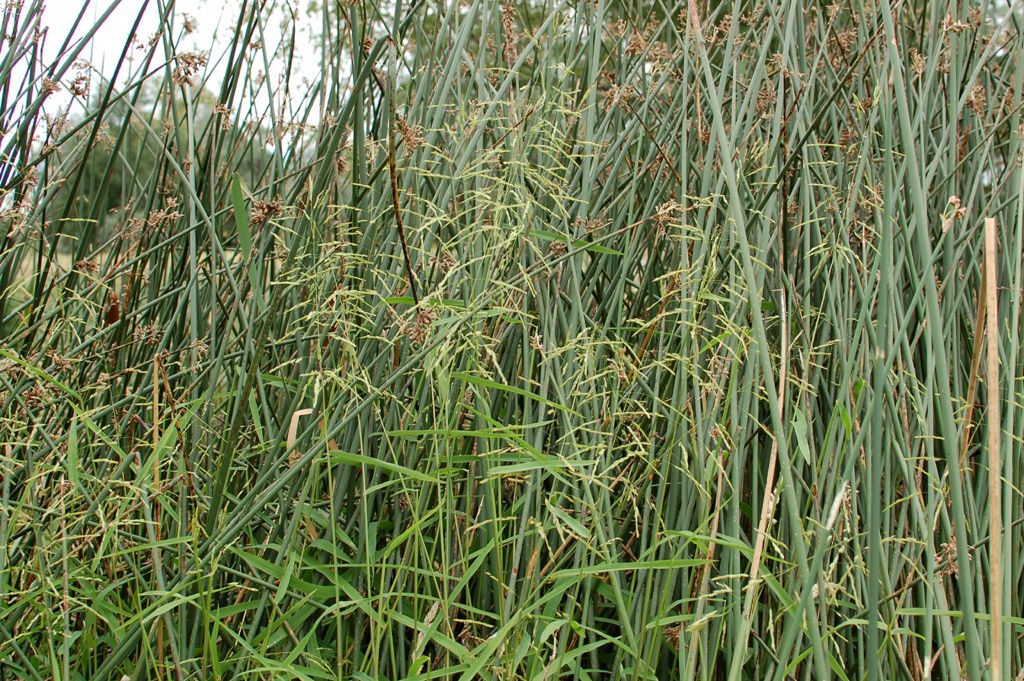This species is found throughout the state but on account of its habitat and light requirements it is infrequent. It prefers full sunlight and is found in low, wet places, especially along ditches, old river channels, outlets of springs, in springy places, and about lakes. The species varies considerably. In late flowering forms, sometimes the panicles do not expand and are included. Rarely forms with smooth sheaths are found.
Common Name: rice cutgrass
Duration: Perennial
Nativity: Native
Lifeform: Graminoid
General: Creeping perennial grass from long, slender rhizomes; stems to 1.5 m tall, decumbent and rooting at the nodes, the terminal portions of the stems erect; nodes soft-hairy with distinctive bands of short white hairs.
Vegetative: Blades flat to folded, 10-28 cm long and 8-14 mm wide, the margins and surfaces strongly scabrous, the margins with downward-pointing teeth; sheaths glabrous to minutely scabrous; ligules membranous, to 1 mm long, with truncate apices.
Inflorescence: Open and panicle-like with arched to wavy lateral branchlets and spikelet stalks. Spikelets 1-flowered, laterally compressed, glumes absent, lemmas and paleas firmly membranous; lemmas 4-5 mm long, boat-shaped, hispid to strigose on the back, awnless, 5-veined; paleas 3-nerved, much narrower than lemmas, oblong to narrowly elliptic; palea margins firmly held by the margins of the lemmas; spikelets disarticulating from the pedicels.
Ecology: Found in marshes, near streams and ponds, to 4,000 ft (1219 m); flowers July-October.
Distribution: Widespread and native throughout the United States, s. CAN, n. MEX, Europe and Asia. Introduced to Macaronesia and Australia.
Notes: This distinctive creeping grass is found in wet or marshy environments. Look for a diffuse panicle emerging from the upper leaf sheath; single-flowered spikelets that break off at the pedicel, leaving no glumes behind; bands of felty pubescence at most stem nodes; and blades with an obvious midvein on the lower surface. Also be careful of the tiny downward-pointing teeth on the margins of the blades, which are difficult to see but capable of drawing blood from careless handlers, giving the species its common name.
Ethnobotany: Unknown.
Etymology: Leersia is after German botanist and pharmacist Johann Daniel Leers, and oryzoides means like genus Oryza, rice.
Synonyms: Homalocenchrus oryzoides, Phalaris oryzoides
Editor: LCrumbacher 2012, AHazelton 2015
Culms decumbent and sprawling, rooting at the nodes, distally erect, to 15 dm; sheaths roughly retrorse-scabrous; ligule truncate, to 1 mm; blades very rough-margined with stiff colorless spinules, the main blades 15-30 cm נ6-15 mm; panicles pale green or whitish, the terminal one to 30 cm, exserted or partly included, its slender branches ±spreading when exserted; lower part of the panicle with 2 or 3(4) branches per node; spikelets ascending, 4-7.5 mm, a fourth to a third as wide, imbricate in spike-like clusters of 3-8 ending the branches; lemma pilose, stiffly ciliate on the keel; stamens 3; late-season axillary panicles reduced and ±included in the sheaths; 2n=48. Swamps, wet meadows, and muddy soil; Que. and N.S. to B.C., s. to Calif. and Fla.; Europe; e. Asia. Estuarine plants vary to a flaccid, virtually glabrous phase with included panicles.
Gleason, Henry A. & Cronquist, Arthur J. 1991. Manual of vascular plants of northeastern United States and adjacent Canada. lxxv + 910 pp.
©The New York Botanical Garden. All rights reserved. Used by permission.

















